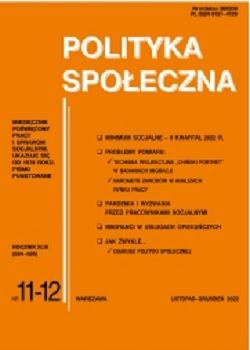
- The use of the projective technique method "Chinese portrait" on the example of migration research
The aim of the text is to convey the experience of qualitative research in the area of migration using the projective technique of the "Chinese portrait" used so far mainly in marketing research and psychology. As part of a scientific project devoted to the perception of Polish and Ukrainian labor markets by Poles and Ukrainians, in order to obtain more detailed opinions of respondents, it was decided to use the "Chinese portrait" projection technique. This brought very interesting results that allowed to verify the information obtained in quantitative and qualitative research conducted using an in-depth interview questionnaire. At the same time, during the implementation of the study, several challenges emerged that required taking into account both the projection technique and data interpretation. The text encourages the use of projective techniques in social research. It also points out the main challenges associated with it and suggests how to deal with them.
- The sense of workload of social workers during the pandemic
The time of the pandemic is a difficult time for everyone. This situation is also a significant burden for the staff of social welfare institutions. The fact that the institution was approached by people who had not previously been recipients of benefits, as well as the manifestation of negative behavior by clients, creates unfavorable conditions for effective work. In addition, organizational changes related to partly remote work, reduced effectiveness of aid work, lack of sufficient social support from superiors and co-workers reinforce the feeling of overwhelm and exhaustion. The article is empirical in nature. The aim of the research was to diagnose the sense of workload of social workers during the pandemic. The research was conducted in 2021 on a sample of 129 social workers from all over Poland. The selection of the group for the research was purposeful, and the criterion adopted was employment as a social worker in a social assistance centre. The research method was the diagnostic survey method. The results of the research showed that most social workers worked in hybrid mode during the epidemic. They provided psychological support to those in need, coordinated the delivery of food to people in quarantine, or delivered it personally. An important area of work was the support of the elderly. The research results indicate that the vast majority of social workers feel extremely burdened by the fact that social welfare clients try to manipulate them and that they come to the center under the influence of alcohol or other intoxicants. A very significant burden is the fact that the respondents deal with too many customers. For the vast majority of social workers, it is extremely burdensome to achieve remuneration for work that is disproportionate to the workload.
- Limitations of the occupational barometer in diagnosing the labor market
The article presents the results of research on the methodology used in estimating surplus and shortage occupations by labor offices within the so-called occupation barometer. The aim of the research was to try to diagnose to what extent the occupational barometer reflects the actual situation on the labor market. The research method was a survey with the use of an online questionnaire. The study involved 173 people who were participants of panels in employment offices identifying surplus and deficit professions. The following defects in the applied methodology were diagnosed: panel participants are mainly employees of labor offices, drawing conclusions about the situation on the labor market is based mainly on the reported job offers and registered unemployed (the phenomena on the labor market not registered in labor offices are taken into account to a small extent). The respondents' opinion on the role of universities and the situation of their graduates on the labor market was also surveyed. The respondents have rather incomplete knowledge about the employability of university graduates. The respondents also point to the difficulty in forecasting the situation on the labor market. Almost everyone agrees that the labor market will increasingly require reskilling. The main research hypothesis was confirmed. The Occupational Barometer reflects the actual situation on the labor market to a small extent. The research allowed for the formulation of several recommendations for possible use by labor offices.
- Social minimum in Poland in the second quarter of 2022
The article presents estimates of the subsistence minimum in the second quarter of 2022. Model values were estimated assuming conditions close to normal, i.e. without restrictions resulting from the risk of SARS-CoV-2 infection. The state of epidemic in Poland was lifted on May 16, 2022. If research showing household consumption becomes a premise for changes in the minimum model, these estimates can be repeated. Taking into account the rising inflation (5.8% in Q2 vs. Q1) and the general uncertainty resulting from the war in Ukraine, the external conditions on the labor market were moderately good: the registered unemployment rate in June amounted to 4.9% (down by 0.5 pp. compared to the data from March this year), the number of employees remained at a similar level, and the average salary in the economy amounted to PLN 6,156.25, which compared to March this year. meant a decrease of 1.3 pp. The values of the subsistence minimum increased from 5.2% (a single pensioner's household) to 7% (a three-person household with an older child). When it comes to the main groups of needs in the model, compared to the first quarter of this year. the cost of food increased between 9.2 and 9.5%, with a CPI of 6.5% for this group. On the other hand, expenditure on housing and energy carriers increased from 4.0% to 4.2%, with higher CPI dynamics for this group (6.3%). Based on the analogous period (Q2 2021), with inflation at 13.9%, the values of the subsistence minimum increased from 10.3 to 10.4% in one-person households, to 14.7% in a three-person household with a child older.
Polityka Społeczna (Social Policy) - the whole list







